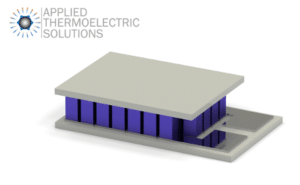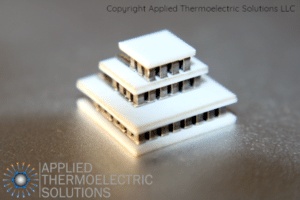To understand how heat is transported in a Peltier module, it is necessary to understand the construction of a Peltier module.
A semiconductor couple is the basic building block of a thermoelectric / Peltier module. A couple consists of one p-type and one n-type semiconductor block connected by a metallic strip.
These semiconductor blocks are also called thermoelements. The p and n semiconductor blocks are connected electrically in series and thermally in parallel.
The metal strip serves as a junction between the two semiconductors. When DC current is passed through the couple, heat is absorbed at the cold side junction and heat is released at the hot side junction.
To create a Peltier module, many couples are placed electrically in series and sandwiched between substrates that are generally ceramic.
The cooling capacity scales directly proportional to number of couples in the module.
In addition to connecting the couples electrically in series, sometimes the couples are connected electrically in parallel or series-parallel to reduce the electrical resistance of the module.

How is heat transported in a Peltier Module?
The heat transport in a Peltier module can explained with charge carrier analysis.
In thermoelectric materials, charge carriers are electrons and holes.
Electrons carry a negative charge and holes carry a positive charge. In n-type materials, the charge carriers are electrons and in p-type materials, the charge carriers are holes.
Holes are empty spaces in a crystal lattice that an electron could occupy.
These holes are free to move about within the lattice. When charge carriers move they take heat with them.
Energy absorbed and liberated can be accounted for by a change in energy level of electrons. Electrons that move to a higher energy level absorb heat and electrons that move to a lower energy level release heat.
The material characteristics and polarity of the DC source relative to the p and n arrangement makes possible energy absorption and release in a controlled manner.





2 Responses
Why don’t you use a transistor type Peltier module to reduce voltage at the heat dissipating end and
I ask you a question. What if a transistor could generate heat only and if we reverse engineer the same transistor to a cold dissipating transistor it would only dissipate cold and no heat will be generated.
Tim, Interesting idea. I am not familiar with the concept. Thank you for posting.